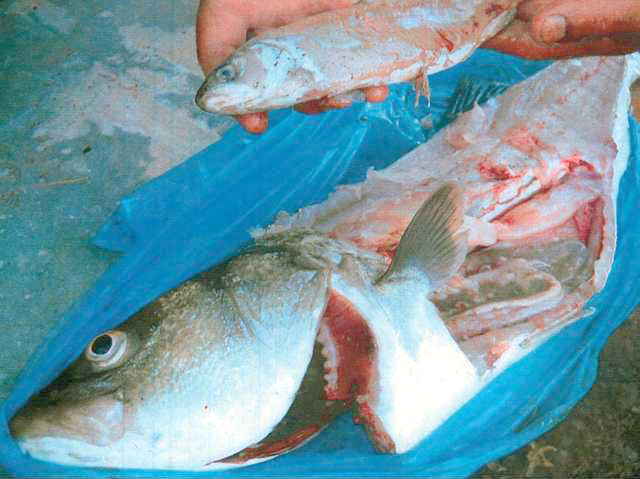The Bureau of Reclamation has made a strong case to declare the non-native bass Public Enemy No. 1 in California’s perennial water wars.
And the U.S. Fish & Wildlife Service has indirectly agreed.
Decisions by the federal agencies this past week could end up having major ramifications on the Sacramento-San Joaquin Delta’s future, blow a big hole in a major argument for the Delta tunnel, and reset how water much water even in drought years is sent into the San Francsico Bay.
*The Bureau of Reclamation completed its environmental review of a plan to help the humpback chub and other protected fish in northern Arizona, allowing the agency to release cold water from the Glen Canyon Dam to combat the warm water-loving invasive smallmouth bass species that threatens the native population.
*To save the imperiled spotted owl from potential extinction, U.S. wildlife officials are embracing a contentious plan to deploy trained shooters into dense West Coast forests to kill almost a half-million barred owls that are crowding out their cousins.
Each vetted plan reached the same decision: It is environmentally sound and effective to reduce the numbers of non-native species to strengthen the number of threatened native species.
Both decisions — although one deals with fowl and not fish — give credence to the potential effectiveness of a plan batted down in Sacramento 13 years ago to save the threatened salmon and steelhead.
The plan was an aggressive cutback on the non-native bass that are huge consumers of the native salmon and steelhead as well as the almost extinct Delta Smelt.
Scientific research underlined the predatory problem noting almost 90 percent of the salmon that enter the Delta never made it past Vernalis — a point near the Airport Way bridge south of Manteca — to eventually reach breeding areas on the Stanislaus, Tuolumne, and Merced rivers.
For years the state-federal regulatory cartel emboldened by court decisions have been releasing more and more water from reservoirs to try and prop up the salmon population.
They have been curtailed water deliveries at the pumps at the start of the California Aqueduct to reduce the loss of Delta Smelt.
Water delivery reductions in a bid to reduce Delta Smelt from being killed — even though it has not made a measurable difference in the species’ population — is a big reason there is a push for the tunnel.
Back in 2013, the lucrative bass sportfishing industry successful fought a plan before the California Fish and Game Commission to reduce the impact of the non-native bass on the non-native fish population in the Delta.
Bass, that were introduced to the Delta ecological system by man, took to it like fish take to water.
The bass thrived given the smorgasbord of native fish.
Some of the largest bass fish can now be found in the delta which helps to lure fishermen from all over the country.
But the question is what is more important — protecting native fish and by extension water supplies for California cities and farms or making sure there is a robust bass sport fishing industry?
The plan was never to eradicate the bass but to bring their numbers — and the size of bass — under control to enhance the survival rate of non-native fish they are devouring.
The proposal was centered around having $5 a head bounty program to help bring a truce to California’s water wars.
It is an out-of-the-box solution rooted in three facts.
*There are a number of non-native predatory fish species in the Delta that are impacting salmon and steelhead population.
*The Delta — in its current form — is a manmade creation and not natural.
*The population of native fish plays a pivotal role in shaping the state’s water policy.
Some critics contend the Department of Fish & Game’s emphasis on cultivating a bass fishing industry in the Delta is detrimental to the economic health of California and the survival rate of salmon and steelhead.
They cite studies — including estimates by state biologists — showing non-native predators consume between 18 and 50 percent of the native fish population.
If the population of predators is reduced and the number of salmon and steelhead rebounds, it would alter the landscape of California water politics.
If native fish can survive in greater numbers by reducing the ranks of predators imported by man, then it could allow changes in water diversion for farm and urban uses.
That, in turn, would reduce pressure to build more massive reservoirs, significantly weaken the argument for a tunnel, and ease up on groundwater pumping to keep up with California’s insatiable demand for water.
A bounty program would be fairly straight forward.
If bass prove to be one of the key culprits, the state would need to allow bass fishing year round with no limits. Then they would need to put in place a bounty program where authorized bait stores are contracted to serve as agents of the state.
For every bass a customer brings in, they would receive $5. The head would be cut off and the rest of the fish returned to the angler.
They get money and food while the store gets a commission from the state much like how the lottery operates.
Funding of the program wouldn’t be too hard to come by.
Irrigation districts and urban water works that would benefit from the end result would probably be more than happy to cover the cost.
It also would create “jobs” as a fisherman could easily generate a reasonable amount of money.
In the noise we make over water in California we forget that there is water flowing in the Delta in large amounts in early October because of the vast reservoirs and levee system put in place by man.
Without it, droughts we’ve experienced since the 1980s would have dried up much other Delta and killed off even more fish than are caught in the massive pumps that send water south to farms and urban users.
We also forget that non-native species can severely upset the balance.
It makes more sense to try a fish bounty program than going down the myopic tunnel path now being carefully touted as a “conveyance” system around the Delta.
Besides, a $5 a head fish bounty is certainly more cost effective than a $20 billion tunnel.
This column is the opinion of editor, Dennis Wyatt, and does not necessarily represent the opinions of The Bulletin or 209 Multimedia. He can be reached at dwyatt@mantecabulletin.com



